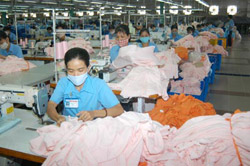INDOCHINA INTERNATIONAL CONSULTING CO., LTD
HO Add: 62L/36 Nguyên Hồng, Ward 11, Bình Thạnh District, HCMC - Vietnam
Biz Office Add: #48 Road No 11, Quarter 6, Hiệp Binh Chánh Ward, Thủ Đức, HCMC - Vietnam
®Source: http://viipip.com should be clearly quoted for any use of information extracted from our website.
Publication permit No: 60/GP-TTĐT , April 05, 2010.


What would you say about achievements and losses in the last two years, since Vietnam officially joined the WTO?
The biggest thing Vietnamese garment companies have got from WTO membership is more opportunity, though Vietnamese goods exported to the US are still being monitored by US agencies.
The loss is that most Vietnamese companies were not well prepared for the integration, so they have been influenced by the economic recession in the world, especially in the US, the biggest export market for Vietnamese companies.
In other words, Vietnamese enterprises were told to get ready for the fight, but they have not armed themselves well enough.
Before Vietnam joined the WTO, experts predicted that a lot of small garment companies would go bankrupt. How many garment companies have gone bankrupt so far?
Bankruptcy has now begun occurring with some enterprises which have weak ‘resistance’.
China has reckoned that 67,000 of its businesses have gone bankrupt. I think that the Vietnamese garment industry will also suffer heavily in the time to come due to the difficulties of the US economy and higher domestic labour costs.
The big advantage of Vietnam’s WTO membership is that Vietnamese apparel products now are not hindered by trade barriers anymore. Could you please tell us how Vietnamese companies have been taking advantage of this?
The trade barriers have been removed, but technical barriers installed in their place. Vietnamese enterprises were warned about this but not all have been able to avoid it.
One of the advantages of Vietnamese garment companies is the cheap labour cost. However, Vietnamese garment companies are now under pressure to raise the salaries of their workers. What do you think Vietnamese garment companies need to do?
Garment companies still can have low labour costs if they go the right way. For example, they need to make products with high commercial value in order to offset labour costs. They also need to improve productivity, which allows higher values with the same production chains and numbers of workers.
Moreover, enterprises should also strive to export products under the FOB mode instead of doing the outsourcing for foreign partners.
As of January 1, 2009, China will enjoy the non-quota scheme. Worries have been raised that orders will flow into China instead of Vietnam. What do you think about this?
I think the problem is not worth worrying about. We can foresee three scenarios. The best one is that the US would remove the monitoring scheme on Vietnam, while continue applying the scheme on China. President elect Obama’s speech implied that the US would control imports from China.
The less positive scenario is that the US would apply the monitoring scheme on both Vietnam and China, and the worse scenario that the US tightens imports from Vietnam and loosens imports from China. But I don’t think the third scenario will occur. China remains the biggest exporter to the US, while Vietnam is only in the top 10.
I have also heard other information, such as that US importers want to shift orders from China to Vietnam due to increased costs, especially labour costs.
- FDI capital continues to pour into Vietnam (6/11/2025 1:20:33 PM)
- Thanh Hoa receives good news: Preparing to have an additional industrial park of up to 470 hectares, creating jobs for nearly 30,000 people (6/11/2025 1:15:09 PM)
- Industrial Park Real Estate: Waiting for the New Generation of FDI (6/11/2025 1:10:15 PM)
- A wealthy Vietnamese city will have two special economic zones after the merger (6/11/2025 1:04:42 PM)
- 30 billion USD capital FDI in Việt Nam by 2025, a series of "ông big" races to expand the land fund (6/11/2025 12:55:26 PM)
- the 2nd largest city in the North will start construction on an international economic zone (6/11/2025 12:50:20 PM)
- Japanese giant Sumitomo continues to want to build an industrial park in the countrys fourth smallest province. (6/11/2025 12:40:45 PM)
- 3 foreign corporations want to invest billions of dollars in Ba Ria - Vung Tau (6/11/2025 12:34:30 PM)
- Lotte Group member starts construction of nearly 1,000 billion VND logistics center in the province with the most industrial parks in Vietnam (6/11/2025 12:33:26 PM)
- Forming a regional center for manufacturing spare parts and components (6/11/2025 12:24:08 PM)
- Vietnams first wafer factory is about to start construction (6/11/2025 12:19:09 PM)
- Dong Nai attracts foreign investors (6/11/2025 12:13:27 PM)
- Tay Ninhs largest industrial park welcomes a $150 million high-end knitted fabric factory project (6/11/2025 12:11:00 PM)
- (6/11/2025 12:09:10 PM)
- Vietnam will become a destination for Chinese investors in the future (11/6/2023 1:03:19 PM)

- FDI capital continues to pour into Vietnam
- Thanh Hoa receives good news: Preparing to have an additional industrial park of up to 470 hectares, creating jobs for nearly 30,000 people
- Industrial Park Real Estate: Waiting for the New Generation of FDI
- A wealthy Vietnamese city will have two special economic zones after the merger
- 30 billion USD capital FDI in Việt Nam by 2025, a series of "ông big" races to expand the land fund










 ADB: Vietnam’s 2009 GDP growth to be highest in South East Asia
ADB: Vietnam’s 2009 GDP growth to be highest in South East Asia MGM Grand Ho Tram: Vietnam’s First ‘Las Vegas Style’ Integrated Resort
MGM Grand Ho Tram: Vietnam’s First ‘Las Vegas Style’ Integrated Resort Nha Trang’s Twin Towers project licenced
Nha Trang’s Twin Towers project licenced Foreign investors still have good opportunities in Vietnam
Foreign investors still have good opportunities in Vietnam Sierra Wireless gets a foot in Vietnam’s ICT market
Sierra Wireless gets a foot in Vietnam’s ICT market